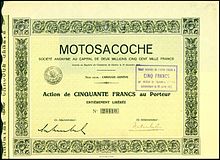Motosacoche

Motosacoche was a Swiss manufacturer of motorcycles and until the Second World War the largest manufacturer of built-in motors in Europe .
history
founding
The company was founded by the brothers Henri and Armand Dufaux in 1899 as Société en commandite H. & A. Dufaux & Co. in Geneva . With the patent no. 21167 from February 24, 1900, a bicycle auxiliary motor appeared , which could be mounted in a subframe in a conventional bicycle in a few simple steps . This construction gave the company the name Motosacoche (in German Motortasche) because the built-in motor could be installed as a complete unit in a subframe using clamps in the frame triangle of a bicycle, as was customary for bags at the time.
Around 1910, Motosacoche built a V2 engine with a camshaft located between the cylinders and upright valves - an elegant construction that, however, easily overheated. Then the valves were moved to the outside, which was possible using long rocker arms . The result was an OHV engine that Clement in France and Matchless in England also used in races. These engines were available in the displacement sizes 350 cm³ and 500 cm³.
Around 1912 a V2 engine with change-over valves ( IOE ) was developed for Royal Enfield (350 cm³) in England, which laid the foundation for the advancement as a built-in engine supplier. The collaboration with Royal Enfield was very close during this time. Motosacoche supplied engines and drive technology and in return purchased chassis, tanks, fenders and wheels from Royal Enfield. It can be assumed that Motosacoche only provided these components with its own motors during this period (until the early 1920s) and painted and assembled them in the Motosacoche colors of khaki / brown.
First and Second World War
During the First World War , the alternately controlled V2 was further developed and other displacement sizes were also made available. This engine was now available as 500, 600, 750, 1000 and also 1100/1150; the 350 for Royal Enfield ran out. Around 1919, Matchless even developed a head-operated 8-valve version based on these engines from the 1000, which was only used on the racetrack. From this, Motosacoche developed the famous Franconi engines, which were head-controlled but had crossed rocker arms , as the crankcase of the alternating-controlled engine was retained. A derivation from the V2 engines was a single cylinder, initially alternately controlled, later also as an OHV in the Franconi design.
The first engines with overhead camshafts were built around 1923, but they were not very stable. In 1927, the famous English designer Dougal Marchand was poached from Chater-Lea ; he designed a brilliant vertical shaft motor with an overhead camshaft for Motosacoche . These engines were not only very fast (the surviving ones are still today, by the way), but also durable.
In 1927, Motosacoche launched a new series of civil engines, the OHV versions of which featured a partially encapsulated valve train - rocker arms and valve stems were exposed. The anniversary series came onto the market around 1930 - these in turn were OHV and SV engines with a large oil pan - and a commercially available racing engine (type D) that looked like a vertical shaft engine. In fact, however, the bumpers moved in a common duct to the rocker arms in the cylinder head. In 1931 the last V2-cylinder development from Motosacoche appeared, the type 720 - a side-controlled 850 with battery ignition and dry sump lubrication . One last serious rebellion in terms of racing was a type F vertical shaft motor in 1935, which, however, was not powerful enough to be internationally competitive.
Among Motosacoche's motorcycles, the famous coffee grinder models deserve special mention, the chain transmission of which was to be shifted with a gear lever on the petrol tank that was turned like a coffee grinder. In the mid-1920s, the most interesting models were the Franconi with one- and two-cylinder OHV engines. The color scheme (until 1929 khaki / brown) was changed in 1930 for the anniversary models to khaki / red.
post war period
After the Second World War, Motosacoche made one more attempt to regain a foothold in the motorcycle business. In 1952 a two-cylinder 250 series came out, the engine of which came from Richard Küchen. The remaining parts of the motorcycle were supplied by UT near Stuttgart ; they were painted in Geneva and then assembled. In 1956, motorcycle production at Motosacoche finally ended.
Furthermore, engines were still manufactured for agricultural use, e.g. B. for motor mowers. The built-in motors were called MAG , which stands for Motosacoche Acacias Genève .
Cycles
Motosacoche also produced bicycles and sold them under Motosacoche as its own brand or among others even in the typical Motosacoche colors if they were offered by retailers under their brand, for example as Egni from a bicycle dealer in Egnach .
Automobiles
Between 1922 and 1928 Motosacoche manufactured around 200 copies of a small car and marketed it as Maximag.
Slot machines
The Motosacoche company also produced slot machines. This is little known, but there was a separate machine department. The machines are rare these days and are therefore in great demand.
Web links
Individual evidence
- ↑ Harald H. Linz, Halwart Schrader : The International Automobile Encyclopedia . United Soft Media Verlag, Munich 2008, ISBN 978-3-8032-9876-8 .







